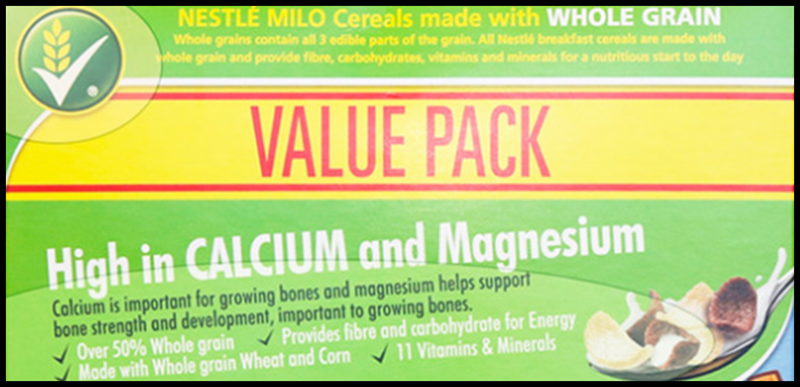
Fat free and 100% natural: seven food labelling tricks exposed
Sandra Jones, University of Wollongong
If you’re confused by food labels, you’re not alone. But don’t hold your breath for an at-a-glance food labelling system that tells you how much salt, fat and sugar each product contains. Australia’s proposed “health star rating” labelling scheme was put on hold in February, following pressure from the food industry. And it’s unclear whether the scheme will go ahead.
Marketers use a variety of tricks to make foods seem healthier and more appealing than their competitors, particularly when it comes to products aimed at children. One of the most powerful advertising tools a food manufacturer has is the packaging, as it’s what we look at immediately before deciding which food to purchase.
Next time you’re shopping for food, look out for these seven common labelling tricks:

The colour of food packaging can influence our perceptions of how healthy a food is.
A recent study found consumers’ perceptions of two identical chocolate bars were influenced by the colour of the nutrition label; despite the identical calorie information, people perceived the one with the green label to be healthier.


Another tool of savvy food marketers is the use of “ticks” and “seals” that we subconsciously process as indicating that the product has met some form of certification criteria.
A recent study found that nutrition seals on unhealthy food products increased perceptions of healthiness among restrained eaters. And a study with parents of toddlers found 20% of parents identified the presence of a quality seal as one of the reasons for their purchase of toddler formula rather than cow’s milk.



Food packaging often contains words that imply the food contains certain ingredients, or has been prepared in a way, that makes it healthier (or at least better than similar foods).
But many of the words – such as “healthy” or “natural” – have no legal or formal meaning. While the Australian New Zealand Food Standards Code regulates the use of specific health and nutrient content claims, it doesn’t regulate or define these loose terms.
“Weasel claims” describe modifiers that negate the claims that follow them. This allows manufacturers to avoid allegations of breaching advertising or labelling regulations, while being such a commonly used word that it is overlooked by the consumer.
For example, Activia “can” help to reduce digestive discomfort – but did you read the fine print? It “can” help if you eat it twice a day and “… as part of a balanced diet and healthy lifestyle”.

Similarly, Berri Super Juice contains antioxidants which “help” fight free radicals (but so does whole fruit, which also contains more fibre).


Unfinished claims tell us the product is better than something – but not better than what. In food labelling, we really have to hunt for the “what”.

Fountain’s Smart Tomato Sauce still contains 114mg of salt per serving, while the brand’s regular tomato sauce contains 186mg (more than several other brands).
The Heart Foundation defines low-salt foods as those with less than 120mg per 100g; Fountain’s Smart tomato sauce has 410mg per 100ml. It does, however, have less sugar than many of its competitors.
So, if you are trying to reduce your sugar intake it may be a good choice, but if you are trying to reduce your sodium intake, look for one of the low-salt varieties and read the label very carefully (reduced is rarely synonymous with low).

Smiths’ Thinly Cut potato chips contain 75% less fat than “chips cooked in 100% Palmolein Oil”. But they don’t contain less fat than Original Thins, Kettle, or most other brands on the market.
It’s also worth taking a close look at the recommended serving size – in both cases the nutrition information is based on a 27g serving, but Smiths’ “single serve” pack is 45g (15.7g fat; one-fifth of an average adult’s recommended daily intake, or RDI).

A common strategy is to list a claim that is, in itself, completely true – but to list it in a way that suggests that this product is unique or unusual (when in reality it is no different to most foods in that category).

“All natural” and “no artificial colours and flavours” are appealing features for parents looking for snacks for their children. But most standard cheeses (including many packaged products such as cheese slices) also contain no artificial colours of flavours.
This is not to suggest that Bega Stringers are a bad product or that you shouldn’t buy them – just that you may want to think about the cost per serve compared to other cheeses that are equally healthy.
Like most lolly snakes, Starburst snakes are “99% fat free”. The old adage of “salt-sugar-fat” holds here; products that are low (or absent) in one are typically very high in another. In the case of lollies, it’s sugar.

As with the potato chips above, serving size is important. Those of us who can’t resist more than one snake might be surprised to realise that if we ate half the bag, we would have consumed two-thirds of our daily sugar intake (although we can’t blame the pack labelling for that!).

Sun-Rice Naturally Low GI White Rice illustrates this use of technically correct claims. Let’s start with “cholesterol free” – this is totally true, but all rice is cholesterol free.

The pack also states in very large, bright blue letters that it is “Low GI”. In much smaller letters that almost disappear against the colour of the package is the word “naturally”. This use of different colours to attract, or not attract, attention is a common marketing technique.
The product is indeed low GI, at 54 it is just below the cut-off of less than 55. But the “naturally” refers to the fact that what makes it low GI is the use of basmati rice rather than another variety, and other brands’ basmati rice would have a similar GI.


Berri Super Juice proudly, and truthfully, claims it “contains no added sugar”. You may conclude from this that the sugar content is low, but a closer look at the nutrition information label may surprise you – a 200ml serve of this super juice contains 25.8g of sugar (29% of your recommended daily allowance).

While contentious, some have even suggested that there is a link between fruit juice and both obesity and metabolic disease, particularly for children. A better (and cheaper) way of obtaining the fruit polyphenols is to eat fruit.

Healthy sounding words are not only used as “claims” but are often used as brand names. This first struck me when I was looking for a snack at my local gym and noticed the “Healthy Cookies” on display; they had more sugar, more fat and less fibre than all of the others on sale (Healthy Cookies was the brand name).
Brand names are often seen as a key descriptor of the nature of the product. Research has found that people rate food as healthy or unhealthy based on pre-existing perceptions of the healthiness of a product category or descriptor, particularly among those who are watching their diet, and may thus select the unhealthier option based on its name or product category.
If, for example, you’re watching your weight, you may be attracted to the Go Natural Gluten Free Fruit & Nut Delight bar, assuming that it will be a healthier choice than a candy bar. But you might be surprised to note that it contains 932 kJ (11.0% of your RDI) and a whopping 13.6g of fat (10% of your RDI).

A 53g Mars bar contains slightly more calories (1020kJ) but a lot less fat (9.1g), although the Go Natural bar could argue for “healthier” fat given the 40% nut content.
So, can we really distinguish between healthy and unhealthy foods by looking at the wrappers?
The healthiest wrappers are made by nature, from the simple ones that can be eaten after washing (like apples and carrots) to those that need some disposal (like a banana or a fresh corn cob).
If you are buying your food wrapped in plastic or paper, it’s a little more complex. We need to see past the colours, pictures and cleverly-crafted claims and take a careful look at the ingredients and nutrition panel.
Sandra Jones, Professor and Director of the Centre for Health Initiatives , University of Wollongong
This article was originally published on The Conversation. Read the original article.



